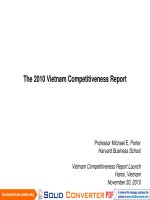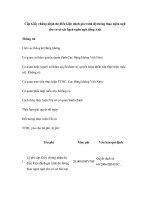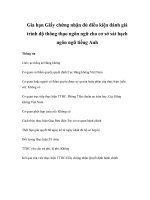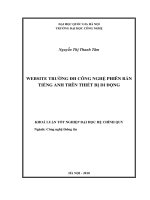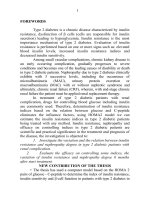sổ tay thuế phiên bản tiếng anh
Bạn đang xem bản rút gọn của tài liệu. Xem và tải ngay bản đầy đủ của tài liệu tại đây (1.5 MB, 83 trang )
IMPORTANT NOTES
IN CORPORATE ACCOUNTING POLICIES
PROMULGATED UNDER THE CIRCULAR
NO. 200/2014/TT-BTC
INTRODUCTION
The Circular No. 200/2014/TT-BTC dated 22nd December 2014
issued by the Ministry of Finance should be considered as a major
important guidance with the aim of changing accountants'
thoughts and gradually taking the corporate accounting policies
of Vietnam to the international accounting standards.
Within the scope of this newsletter, AASC will help you to catch
the differences or further clarifications in the Corporate
Accounting Policies recently promulgated in comparison with the
former Corporate Accounting Policies passed under the Decision
No. 15/2006/QĐ-BTC. We believe this document is useful for you
during the course of accounting operations.
It is easy to compare with the volumes of the Corporate
Accounting Policies originally promulgated under the Decision on
Publishing No. 16/QĐ-NXBTC dated 27th January 2015 (ISBN:
987-604-79-0730-4 and 978-604-79-0731-1) issued by the
Ministry of Finance by looking for the page number as stated in
the reference column. For example: Tr8-Q1: the 8th page of the
Corporate Accounting Policies -Volume 1 as mentioned above.
We would also note that the number of pages can be changed in
case you refer to other volumes than our newsletter as stated
above.
Yours sincerely,
PRINCIPLES OF CORPORATE ACCOUNTING POLICIES
1 . In accordance with the reality, modern and feasibility;
2 . Respect the nature of the economic operation other than the
form;
3 . To be flexible and open; consider the satisfaction of the manage,
executive, decision-making, serving investors and creditors as a
main focus; not accounting for tax purposes;
4 . In accordance with the international standards;
5 . Separate the accounting techniques on accounts and Financial
Statement; the definition of the long-term and short-term only
applying to the preparation of Balance Sheet and not applying to
the accounts;
6 . Raise the responsibilities of the accountants.
Content
Ref Column
PART 1 : GENERAL PROVISIONS
Applying for enterprises in every business line and in
every economic sector. For small and medium sized
enterprises (SMEs), this Circular guiding these
enterprises on utilizing the applicable accounting
policies to fit with their nature of business and
management requirements.
Art 1 - Cir 200
P7-Vol 1
Scope:
Art 2 - Cir 200
P8 - Vol 1
Guidance on recording, preparing and presenting the
Financial statement, but not applying for determining tax
liabilities of enterprises to the State budget.
Identifying the monetary unit in accounting
1. For enterprises whose transactions involved mainly in
foreign currencies shall base on regulations of the Law
Pro 1 - Art 4
Cir 200
P8 - Vol 1
on accounting for consideration, selection of monetary
unit used in accounting, take legal responsibility and
notify to supervisory tax authority.
2. The monetary unit in accounting means:
a) Primarily used in trading goods, rendering of
services, defined as the posting price and used for
payments; and
b) Used mainly in purchasing goods, services which
have great impact on operating costs and considered as
the payment of that costs.
1
Pro 2 - Art 4
Cir 200
P8 - Vol 1
Content
Ref Column
Conversion of financial statements made in foreign
currency into Vietnamese dong (VND)
1. If an enterprise uses a foreign currency as monetary unit
in accounting, it must not only prepare a financial
Pro 1 - Art 5
Cir 200
P9 - Vol 1
statement in foreign currency but also converse their
financial statement into Vietnamese dong when
announcing and submitting the financial statement to
regulatory authorities
2. When converting the financial statement made in
foreign currency into Vietnamese dong, the enterprise
Pro 3 - Art 5
Cir 200
P9 - Vol 1
must clarify the impact (if any) on the financial statement
due to the conversion in the Description of financial
statement.
3. The lawful financial statement used to announce and
submit to Vietnamese competent agencies is a financial
Art 6 - Cir 200
P9 - Vol 1
statement made in Vietnamese dong and audited
4. Conversion of financial statement made in foreign
II.11.2 - Cir 200
currencies to Vietnamese dong
a) Rules:
P120 - Vol2
- Assets and liabilities are converted into Vietnam
dong at the actual exchange rate at the end of period
(the transfer rate of a commercial bank where
enterprises regularly trade).
2
Content
Ref Column
- Owner's equity is converted at the actual exchange
rate at the date of contribution of capital.
- Foreign exchange differences and differences upon
asset revaluation are converted at the actual
exchange rate at the date of valuation.
- Undistributed post-tax profits, funds deducted from
undistributed post-tax profits are converted by
calculating according to items of income statements;
- Items of income statements and cash flow
statements are converted at the actual exchange rate
at the time of the transaction or at the average
exchange rates of the accounting period (the
difference does not exceed 3%).
b) Accounting method of foreign exchange differences
arising when converting financial statements prepared
in foreign currencies into Vietnam Dong under the item
"exchange rate differences" - Code No.417 of the
owner's equity of the Balance sheet.
Changes in monetary unit in accounting
1. If there are major changes in managerial and business
operations leading to the monetary unit in accounting
used in economic transactions failing to satisfy the
accounting requirements, enterprises may change their
monetary units in accounting. The change of a monetary
unit for bookkeeping to another may be effected only at
3
Art 7 - Cir 200
P10 - Vol 1
Content
Ref Column
the beginning of a new fiscal year. The enterprise must
notify supervisory tax authority of the change in
monetary unit in accounting within 10 working days after
the final day of the fiscal year.
2. Application of exchange rate in cash accounting:
II.12 - Cir 200
P121 - Vol 2
a) Apply the transfer rate of commercial banks where
enterprises frequently trade in the beginning of period to
convert the balances of accounting books for items on
the balance sheet;
b) Apply the average transfer rate of the period
preceding the change period (if the average exchange
rate is approximate the actual cost) when presenting
comparative information in income statements and cash
flow statements of the period.
3. When changing monetary unit in accounting, the
reasons for changes and inpact (if any) must be clarified
II.12.3 - Cir 200
P122 - Vol 2
in the Notes of Financial Statements.
Rights and obligations of enterprises pertaining to
organization of accounting in dependent accounting
units having no legal status
1. Enterprises must organize their accounting structures
and accounting task delegation of dependent
4
Art 8 - Cir 200
P10 - Vol 1
Content
Ref Column
accounting units in conformity with their operation and
management requirements and not contrary to
regulations of law.
2. The following accounts shall be kept records by
dependent accounting units having accounting
divisions according to the decision issued by the
enterprise:
a) Operating capital which belongs to dependent
accounting unit shall be recorded to liabilities or owner's
equity according to the decision of the enterprises;
b) Transactions in sale, purchase or circulation of goods
or services intra-company: revenues or costs of goods
sold only are separately recorded in each dependent
accounting unit if such circulation creates added value
in the goods or services. The recording of revenues from
internal transactions to the financial statement does not
depend on the format of accounting records (invoices or
internal transaction documents);
c) Task delegation: Depending on centralized or
decentralized accounting model, the dependent
accounting units may record undistributed post-tax
profit or record revenues and expenses.
5
Content
Ref Column
Registration for amendments in Accounting policies
Art 9 - Cir 200
P11 - Vol 1
1. If the enterprise need to add accounts or sub-accounts
or modify accounts or sub-accounts about names,
signs, content and accounting methods, the approval
issued by the Ministry of Finance before the supplement
or modification is required.
2. If the enterprise need to add or modify names, signs,
content of items of the financial statement, the approval
issued by the Ministry of Finance (under the form of
written documents) before the supplement or
modification is required.
3. All accounting documents are optional, enterprises may
design their forms in conformity with their operation and
management requirements.
Accounting policies applying to foreign contractors
who have permanent resident facilities in Vietnam
1. There are particular contractors eligible for particular
accounting policy issued by the Ministry of Finance;
2. Contractors not eligible for particular accounting policy
issued by the Ministry of Finance may whether fully and
partly apply Accounting policies for Vietnamese
enterprises in conformity with their operation and
6
Art 10 - Cir 200
P12 - Vol 1
Content
Ref Column
management, if the contractor applies Accounting
policies for Vietnamese companies fully, it is required to
apply during the fiscal year.
3. The contractor must notify the tax authority of the
accounting policy applied within 90 days from the date
on which it runs business in Vietnam. If there is any
change in applying of accounting policy, the contractor
must notify the tax authority within 15 working days from
the date on which the change occurs.
4. Foreign contractor must keep records of every contract (
including every contract license), every transaction in
details to settle contract and make tax declaration.
5. If a foreign contractor who applies fully Accounting
policies for Vietnamese companies wishes to
supplement or modify the policies, it is required to
comply with Article 9 of this Circular and obtain approval
issued by the Ministry of Finance. Within 15 working
days from the date on which the sufficient documents
are received, the Ministry of Finance must send
response on registration of amendments of accounting
policies to the foreign contractor.
7
Content
Ref Column
Accounting documents
Art 117 - Cir 200
P208 - Vol 2
1. Types of vouchers are under guidance (optional).
Enterprises shall actively develop, design accounting
forms and vouchers in accordance with their operational
characteristics and management requirements which
must meet the requirements of the Law on Accounting
and ensure principles of clear, transparency, timeliness,
easy inspection, control and comparison.
2. If enterprises do not develop and design forms and
vouchers themselves, enterprises may apply the
system of forms and guidance on content of accounting
records in accordance with the guidance in Appendix 3
of this Circular.
3. Enterprises have the peculiar economic and financial
operation under the adjustment of other legal
documents shall apply the provisions of vouchers in
such documents.
4. The decentralization of signing in vouchers shall be
prescribed by the General Director (Director) of
enterprises in accordance with the law, management
requirements ensuring strict control, security of assets.
8
Art 118 - Cir 200
P210 - Vol 2
Content
Ref Column
Accounting Books
Art 122 - Cir 200
1. All forms of accounting records (including Ledgers or
Art 9 Pro 3b
Cir 200
Art 122 - Cir 200
Journals) are optional. Enterprises shall develop forms
of accounting books of their own but must provide
information about economic transactions transparently,
completely, easily to check, easily to control and easily
to compare.
2. In case of not developing forms of accounting books,
enterprises may apply accounting book forms under the
Art 9 Pro 3b
Cir 200
Art 122 - Cir 200
guidance in Appendix 4 of this Circular.
3. Upon detection of any errors of accounting books, they
must be rectified by the methods in accordance with the
Law on Accounting and adjust retrospectively in
accordance with Vietnamese Accounting Standards
No.29.
9
Art 125 - Cir 200
Content
Ref Column
PART 2: SUMMARY OF SOME NEW CONTENTS IN
ACCOUNTING ACCOUNTS
I. Cash accounting
1. Monetary gold is recoreded as cash on hand. Monetary
P31 - Vol1
gold is gold used for value storage, not including the gold
recorded to inventory account (used as raw materials for
production of goods for sale). The monetary gold shall be
re-evaluated according to the buying prices on the
domestic market at the time in which the financial
statement is prepared.
2. Differences due to re-evaluation of monetary gold are
P38 - Vol1
recorded as financial income (if generating profit) or
recorded as financial expenses (if generating losses).
3. The bank overdrafts are not recorded as negative sign on
P38 - Vol1
bank deposit accounts; they shall be recorded similarly to
bank loans.
4. Converting account balance (see the account balance
conversion in page no 44)
II. Transactions made in foreign currencies
1. The principles for determining the actual real exchange
rates:
Real exchange rate upon capital contribution: when
10
P414 - Vol1
Content
Ref Column
record and reevaluate receivables; when record and
reevaluate liabilities; when record ending balance made in
foreign currency; when change monetary unit in
accounting.
2. Application of exchange rates in transactions
-
P416 - Vol1
Transactions received cash in advance of buyers or
prepaid transaction to sellers: apply the real exchange
rate;
-
Revenues or asset purchased related to transactions of
which money is received in advance or prepayment to
sellers: apply the real exchange rate at the time of receipt
in advance of buyers;
-
For credit side of cash capital accounts: apply moving
weighted average method
for exchange rate in
accounting book (apply for each entry).
3. Principles for determining accounts derived from foreign
currencies
a) Definition:
P417 - Vol1
- Cash, cash equivalents, term deposits, debts
receivable, payable derived from foreign currencies,
borrowings, loans, the deposit entitled may be received
back in foreign currencies or sum received from deposit
must be repaid in foreign currency.
- Except for: Prepayments to sellers, prepaid expenses,
sums prepaid by buyers and sums received in advance
in foreign currencies.
11
Content
Ref Column
b) Enterprises must revalue accounts derived from
P419 - Vol1
foreign currencies: at all time of financial statement is
prepared.
4. Accounting methods
-
P419 - Vol1
All exchange rate differencies from operations of
enterprises are recorded on financial statements;
-
Exchange rate losses in the period before operation of
enterprises of which 100% charter capital is held by the
State carrying out projects associated with security and
national defense are recorded on account 413, and are
allocated directly from account 413 to financial expense
but not transferred through account 242 or account 3387;
-
Note: the deferred corporate income tax to the exchange
rate difference due to the revaluation of the balance not
recorded into the taxable income (cash, account
receivables).
5. Converting account balance (see the account balance
conversion in page no 50)
III. Accounting policies for financial investments
1. Account 121: Trading securities
-
Listed securities are recorded at the time of matching
(T+0);
12
P49 - Vol1
Content
-
Ref Column
Unlisted securities are recorded at the time in which the
ownership is acquired as prescribed in regulations of law.
-
In case of dividends are allocated by shares, the investor
P50 - Vol1
only observes the quantity of shares according to the
presentation of financial statement. With regard to
enterprises whose charter capital is wholly held by the
state, the accounting for dividends allocated by shares
shall comply with regulations on state-owned enterprises
(ref: Article 35b- Decree No 71/2013/ND-CP)
-
Before any share is exchanged, its value must be
P50 - Vol1
determined according to fair value on the exchanging
date. The fair value of shares is determined as closing
prices listed on the securities market or closing prices of
UPCOM. In case of other unlisted shares, the fair value of
shares is prices dealt by business contract ( or book
value).
-
When liquidating or transferring trading securities
(according to every type of security), the cost price shall be
determined according to mobile weighted average
method (weighted average for every purchase).
-
The dividends or profits that are used for evaluation (an
P52 - Vol1
increase) of state capital are received; it shall be recorded
as a decrease in value of investment.
2. Account 128: Held to maturity investments
-
Investments held to maturity other than trading securities:
term deposits, Bonds, loans, preference shares that the
13
P55 - Vol1
Content
Ref Column
issuer is required to re-buy them in a certain time in the
future. These investments above shall hold to maturity
to earn profits periodically.
-
This account shall not record investments held for
sales.
-
If it fails to make provisions for doubtful debts as
P55 - Vol1
prescribed, the accountant must evaluate the recovery
and record the losses (if any) to financial expenses.
-
When the financial statement is prepared, the
accountant must re-evaluate short-term investment
classified as accounts derived from foreign currencies
according to actual exchange rates at the end of the
accounting period:
-
Term deposits (long term) now move from account 228
to account 128.
3. Rules for accounting for investments in associates: Acc
221, 222, 228 (remove acc 223)
a) Investments in associates include investments in
subsidiaries, joint ventures and other investments for
capital contribution under the following forms:
-
Investments in the form of capital contribution in
associates;
-
Investments in the form of purchase of capital
contribution of other associates;
14
P55 - Vol1
Content
Ref Column
b) The cost of an investment shall be recorded
P223 - Vol1
according to their original cost, including purchase price
plus directly-attributable expenses;
c) Dividends and profits after investment date shall be
P223 - Vol1
recorded to financial income on the date in which the
dividends and profits are received; When the equitized
enterprise receives the dividends or profits which are
used for evaluation (an increase) of state capital, it shall
not record financial income but record a decrease in
value of investment;
d) If the dividends are received in the form of shares, it is
P224 - Vol1
required to follow rules below:
- Non-wholly-state-owned companies shall only keep
track of number of shares stated in the financial
statement;
- Wholly-state-owned companies shall comply with
regulations of law on wholly-state-owned companies;
Decree No
71/2013/NĐ-CP
P224 - Vol 1
e) When liquidating or selling financial investments,
their costs shall be determined according to moving
weighted average method (weighted average for each
purchase).
g) When preparing the financial statement, the
enterprise must determine value of investment loss to
create allocation for investment loss
15
P224 - Vol1
Content
Ref Column
h) In case the parent company dissolves the subsidiary
P226 - Vol1
and merge all assets and liabilities of the subsidiary
into the parent company, the accounting shall be
done according to rules below:
- A decrease in book value of investments in
subsidiaries of the parent company shall be recorded,
- All assets or liabilities of the dissolved subsidiary shall
be recorded to balance sheet of the parent company
according to fair value on the date on which the
subsidiary is merged into the parent company;
- The difference between the cost of investment in
P231 - Vol1
subsidiary and the fair value of assets and liabilities
shall be recorded to financial income or financial
expenses.
Accounting entry: Debit assets, liabilities acc 635 (if
any)/ Credit account payable, credit Acc221, credit
Acc 515 (if any)
4. Accounting for business cooperation contract (BCC)
a) In any cases, when receiving money or assets from
other entities in the BCC, they should be recorded to
P243 & P338
Vol 1
liabilities (account 338)
b) BCC in the form of jointly controlled assets:
- Both parties involving in BCC must open accounting
book in the same system of accounting records to
record: their portions in the jointly controlled
16
P243 - Vol 1
Content
Ref Column
assets;Any liabilities that incurred from each party;
any liabilities incurred jointly with the other parties in
the relation to the BCC; income or expenses from
BCC, any expenses that incurred in contributing to
BCC.
- Assest which is contributed to BCC and the ownership
of the contributor is not transferred to the joint
ownership of BCC venturers.
- With regard to fixed asset which is contributed to BCC
and the ownership of the contributor is transferred to
the joint ownership; during construction of jointly
controlled assets, the contributor shall include a
decrease in assets and the value of assets shall be
recorded an increase to construction in progress. After
putting jointly controlled assets into operation, the
venturers shall record their increases in assets in
conformity with their use purposes according to value
of their assets' shares.
c) BCC in the form of jointly controlled operations
- Each venture shall bear its own expenses incurred in
jointly controlled operations; the joint expenses shall
be divided to venturers according to the BCC.
- A venturer must open accounting book in the same
system of accounting records to record: assets
contributed to BCC, liabilities that incurs of each BCC
17
P244 - Vol 1
Content
Ref Column
venture, income that it earns from the sale of goods
or services, expenses that incurs of each BCC
venture.
- When receiving products, the venturer must make
receipt slips of products (or delivery order)
d) BCC in the form of shares of post-tax profits:
- When giving shares of post-tax profits under BCC,
all venturers shall appoint a venturer to account for
all transactions in BCC and make tax declaration.
- When entering the BCC, the venture must consider
the risks possibly due to: Any expenses which is not
included in the taxable expense due to failure in
transfer of assets among venturers; Risks of
policies.
- Accounting principal:
. If the BCC regulates that other venturers shall
earn an amount of fixed profit regardless of output
of BCC activities, in this case, the legal form of the
contract is BCC, but it is a lease in the nature. The
venturer in charge of accounting apply
accounting method for lease to the contract, the
other venturers shall record their shares of BCC
to revenues from lease.
. If the BCC regulates that other venturers of BCC
may only be divided profits if the BCC activities
generate profits or losses, in this case, the nature
of BCC is division of revenues and expenses. The
18
P245 - Vol 1
Content
Ref Column
venturer in charge of accounting apply accounting
method for shares of income under BCC to record
revenues, expenses and business output within a
period (make tax declaration to other venturers).
Other venturers shall record their revenues and
expenses are stated in the income statements
under BCC (it does not require the fulfillment in
obligations of BCC to government budget but still
settle the corporate income tax payables: Dr
811/Cr 338).
5. Allowances for impairment of assets:
Use Account 229 to record Allowance for impairment of
investments, Allowance for doubtful debts and
Allowance for decline in inventories.
a) Allowance for impairment of investments
- Allowance for impairment of investments in other
entities: means an allowance for impairment because
the contributee suffers losses.
- For investments in a joint venture or an associate, the
investor only create allowance if the financial
statement is not applied the owner's equity method
for investments.
- For investments not influencing significantly on the
investee: If an investment in listed shares or the fair
value of the investment is determined reliably, the
allowance shall be made according to the market
19
P257 - Vol 1
Content
Ref Column
value of the shares; in case of fair value is not
identifiable, the allowance shall be made according to
the loss of the investee which is recorded in financial
statement.
- Method of accounting for allowance for impairments
P258 - Vol 1
in other entities: If the investee is a parent company,
the investor shall record the allowance according to
the consolidated financial statement; If the investee is
an independent company having no subsidiary, the
investor shall create an allowance according to the
seperated financial statement of such investee.
b) Allowance for doubtful debts:
- Allowance for doubtful debts include the establishing
P262 - Vol 1
or reverting of allowance for doubtful debts and other
held for maturity investments that are similar to
doubtful debts (there are no guidance on accounting
entry).
- The time overdue of the doubtful debt shall be
P259 - Vol 1
determined according to time in which the principal is
repaid, the debt rescheduling between contracting
parties is excluded.
- Requirements of for allowance for doubtful debts:
P259 - Vol 1
must have original documents or promissory note of
the debtor.
- Allowance for doubtful debts shall base on items
presented on the balance sheet which are classified
as short-term or long-term receivables.
20
P61 - Vol 1
Content
Ref Column
6. Converting account balance (see the account balance
conversion in page no 44)
IV. Accounting for receivables
1. Classification of account receivables:
P60 - Vol 1
a) Trade receivables include commercial receivables
generating from purchase-sale related transactions;
b) Intra-company receivables include receivables
between superior organizations and affiliated
organizations having no legal status and dependent costaccounting;
c) Other receivables include non-commercial or nontrading receivables.
2. When preparing financial statements, the receivables
shall be classified into short-term receivables or long-term
receivables according to their remaining terms.
Receivables items of balance sheet may include amounts
recorded to other than receivables such as: loans
(account 1283), deposits (account 244) and advance
(account 141) etc.
21
P60 - Vol 1
Content
Ref Column
3. The receivables conformable to definition of accounts
derived from foreign currencies must be re-evaluated at
P60 & P414
Vol 1
the closing period when preparing financial statements.
4. Export activities from trusted sources:
- The export trustor shall record receivables for sale of
P62 - Vol 1
exported goods from export trustee to account 131
similarly to normal transactions.
- The export trustee shall record payables on behalf of
the export trustor to account 138, including: banking
fees, customs inspection fees, delivery expenses,
material handling expenses, taxes.
5. Intra-company receivables: Account 136
- Dependent accounting unit may be in charge or may
P76 - Vol 1
be not in charge of recording revenues. In case
dependent accounting unit is not in charge of
recording revenues, revenues are recorded to
account 136
For example: In case the dependent accounting unit
is not in charge of recording revenues, value of goods
or services provided for subsidiaries shall be
recorded to internal receivables: Dr 136/ Cr
154,155,156, Cr 333.
- The revenue may be recorded either at the time in
which the goods or services are transferred to
dependent accounting units or at the time in which the
dependent accounting units sell goods or services.
22
P77 - Vol 1
